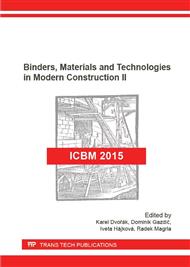[1]
A. Břenek, V. Václavík, T. Dvorský, J. Daxner, V. Dirner: Built-in moisture process in structure with damaged waterproofing after the application of thermal insulation boards, 6th International Conference on Contemporary Problems of Architecture and Construction, Ostrava, Czech Republic, 2014, Vol. 1020, pp.591-596.
DOI: 10.4028/www.scientific.net/amr.1020.591
Google Scholar
[2]
A. Břenek, V. Václavík, T. Dvorský, J. Daxner, V. Dirner, M. Bendová, M. Haničářová, J. Valíček: Capillary active insulations based on waste calcium silicates, Springer Verlag, Mechanical and Materials Engineering of Modern Structure and Component Design (2015).
DOI: 10.1007/978-3-319-19443-1_14
Google Scholar
[3]
A. Břenek, V. Václavík, T. Dvorský, J. Daxner, V. Slivka: Numerical evaluation of peripheral constructions moistening the building after the application of polyurethane plaster and plaster based on aluminosilicate, pp.175-182.
DOI: 10.5593/sgem2014/b42/s18.023
Google Scholar
[4]
V. Václavík, T. Dvorský, V. Dirner, J. Daxner, M. Šťastný: Polyurethane foam as aggregate for thermal insulating mortars and lightweight concrete, Tehnicki Vjesnik Vol. 19 (2012), pp.665-672.
Google Scholar
[5]
H. Künzel, M. Hartwig: Simultaneous heat and moisture transport in building components: one- and two-dimensional calculation using simple parameters, PhD-thesis, Stuttgart (1995).
Google Scholar
[6]
V. Václavík, J. Daxner, J. Valíček, T. Dvorský, M. Kušnerova, M. Harničárová, M. Bendová, A. Břenek: The use of industrial waste as a secondary raw material in restoration plaster with thermal insulating effect, 11th International Conference Binders and Materials 2013 Vol. 897 (1992).
DOI: 10.4028/www.scientific.net/amr.897.204
Google Scholar
[7]
V. Václavík, J. Valíček, M. Novosad, H. Staňková, M. Bendová, J. Daxner: Monitoring of deformation of thermal insulating plaster with fillers from recycled polyurethane foam using conventional geodetic methods, 12th International Multidisciplinary Scientific GeoConference and EXPO (SGEM, Bulgaria 2012), Vol. 4, pp.719-727.
DOI: 10.5593/sgem2012/s21.v4011
Google Scholar
[8]
P. Oravec. Typical renovation measures of brick houses from 1970 – 1990, International Multidisciplinary Scientific Geoconferences, Sofia, SGEM, 2014, pp.27-32.
DOI: 10.5593/sgem2014/b62/s26.054
Google Scholar


